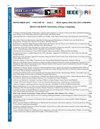Coverage and Performance Analysis of a Private LoRaWAN Network Deployed in Urban Areas
IF 1.3
4区 工程技术
Q3 COMPUTER SCIENCE, INFORMATION SYSTEMS
引用次数: 0
Abstract
The rapid expansion of the Internet of Things (IoT) requires communication protocols capable of supporting long-range connectivity, low power consumption, and robustness against urban interference. LoRaWAN has emerged as a promising Low Power Wide Area Network (LPWAN) technology, but most existing studies have evaluated its performance in controlled or rural environments. This work investigates the coverage and performance of a private LoRaWAN network deployed in Manaus, Brazil, focusing on urban conditions where reflections, obstacles, and multipath phenomena significantly affect communication. The methodology consisted of conducting four testbeds across different city regions using a mobile end device equipped with a LoRa transceiver (RAK3172) configured with AU915 MHz, Adaptive Data Rate, and periodic message transmission intervals of 10 seconds and 1 minute. Messages containing geolocation and timestamps were sent to 11 gateways distributed throughout the city, with data collected and analyzed in terms of signal quality (RSSI, SNR) and network performance (Packet Delivery Ratio PDR). The experimental results demonstrated RSSI values mostly between 100 and 120 dBm, remaining within the operational limits of LoRaWAN, although strongly affected by environmental noise and non-line-of-sight conditions. SNR values varied from 19.8 to +13.3 dB, reflecting interference and mobility impacts.城域网部署专用LoRaWAN网络的覆盖与性能分析
物联网(IoT)的快速扩展要求通信协议能够支持远程连接、低功耗和抗城市干扰的鲁棒性。LoRaWAN已经成为一种很有前途的低功率广域网(LPWAN)技术,但大多数现有研究都评估了其在受控或农村环境中的性能。本研究调查了部署在巴西马瑙斯的专用LoRaWAN网络的覆盖范围和性能,重点研究了反射、障碍和多路径现象对通信产生重大影响的城市条件。该方法包括在不同的城市地区进行四个试验台,使用配备有LoRa收发器(RAK3172)的移动终端设备,配置AU915 MHz,自适应数据速率,周期性消息传输间隔为10秒和1分钟。包含地理位置和时间戳的消息被发送到分布在整个城市的11个网关,并根据信号质量(RSSI, SNR)和网络性能(分组传输比PDR)收集和分析数据。实验结果表明,尽管受到环境噪声和非视距条件的强烈影响,但RSSI值大多在100 ~ 120 dBm之间,保持在LoRaWAN的工作限制范围内。信噪比变化范围为19.8 ~ +13.3 dB,反映了干扰和迁移率的影响。
本文章由计算机程序翻译,如有差异,请以英文原文为准。
求助全文
约1分钟内获得全文
求助全文
来源期刊

IEEE Latin America Transactions
COMPUTER SCIENCE, INFORMATION SYSTEMS-ENGINEERING, ELECTRICAL & ELECTRONIC
CiteScore
3.50
自引率
7.70%
发文量
192
审稿时长
3-8 weeks
期刊介绍:
IEEE Latin America Transactions (IEEE LATAM) is an interdisciplinary journal focused on the dissemination of original and quality research papers / review articles in Spanish and Portuguese of emerging topics in three main areas: Computing, Electric Energy and Electronics. Some of the sub-areas of the journal are, but not limited to: Automatic control, communications, instrumentation, artificial intelligence, power and industrial electronics, fault diagnosis and detection, transportation electrification, internet of things, electrical machines, circuits and systems, biomedicine and biomedical / haptic applications, secure communications, robotics, sensors and actuators, computer networks, smart grids, among others.
 求助内容:
求助内容: 应助结果提醒方式:
应助结果提醒方式:


